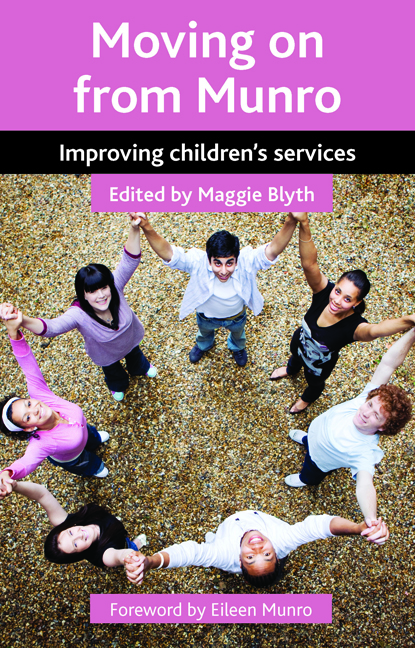Book contents
- Frontmatter
- Contents
- List of abbreviations
- Notes on contributors
- Acknowledgements
- Foreword
- Introduction
- 1 Getting the right things right
- 2 Child protection: 40 years of learning but where next?
- 3 Doing something different: reconfiguring front-line services: opening up the market
- 4 Re-imagining early help: looking forward, looking back
- 5 Children should be seen and heard: understanding the child’s experience
- 6 Responding to adolescent risk: continuing challenges
- 7 Moving on with Munro: child sexual exploitation within a child protection framework
- 8 Missing children post-Munro
- 9 Symbolic half-measures? On local safeguarding children boards, their contributions and challenges
- Conclusion
- Index
Conclusion
Published online by Cambridge University Press: 03 February 2022
- Frontmatter
- Contents
- List of abbreviations
- Notes on contributors
- Acknowledgements
- Foreword
- Introduction
- 1 Getting the right things right
- 2 Child protection: 40 years of learning but where next?
- 3 Doing something different: reconfiguring front-line services: opening up the market
- 4 Re-imagining early help: looking forward, looking back
- 5 Children should be seen and heard: understanding the child’s experience
- 6 Responding to adolescent risk: continuing challenges
- 7 Moving on with Munro: child sexual exploitation within a child protection framework
- 8 Missing children post-Munro
- 9 Symbolic half-measures? On local safeguarding children boards, their contributions and challenges
- Conclusion
- Index
Summary
Implementing the Munro reforms
In a precursor to this volume (Blyth and Solomon, 2012), the editors concluded that while there was overall support from government, professionals and academics for Professor Munro's reforms, there was little information on the detail of implementation. Consequently, there remained some ambiguity about how the necessary changes in improved outcomes for the most vulnerable children and young people would occur. Furthermore, concerns were expressed that a narrow definition of child protection work would undermine progress begun a decade ago under the Every child matters agenda to make safeguarding ‘everybody's business’ (Department for Education, 2004). Indeed, many of the Munro recommendations focused on changing social work practice, with less overt attention given to the wider multi-agency framework in which the child protection system sits. This volume reviews the Munro reforms (Munro, 2011) through a multi-agency lens.
The conclusions of the previous volume highlighted a number of overlapping challenges to the implementation of the Munro review, some echoed by Munro herself in her own review of progress (Munro, 2012). These included: the capacity of the workforce; diminishing public sector resources; the future of early intervention approaches and partnership working; the risk of unintended consequences; and the impact of wider public sector reforms affecting the National Health Service (NHS) and schools. This volume has given attention to these areas, which are dealt with in the following text.
Safeguarding or child protection?
Reviewing progress against the Munro reforms, all contributors to this volume have, to different degrees, considered the impact on the wider multi-agency child protection system. All are in agreement that it is impossible to separate policy and practice about child protection from the legislative context surrounding children at risk across social care, criminal justice, education and health settings. Safeguarding children is the flipside of the coin to public protection and an effective child protection system relies on a shared understanding of risk across health, social care, education and criminal justice agencies (Stephenson and Allen, 2013). In order to protect the most vulnerable children, particularly those at risk of child sexual exploitation (CSE) or going missing (Pearce, Chapter 7; Hedges, Chapter 8), it is essential that front-line services working with children become further integrated.
- Type
- Chapter
- Information
- Moving on from MunroImproving Children's Services, pp. 183 - 190Publisher: Bristol University PressPrint publication year: 2014



